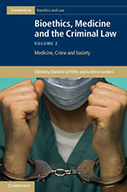Bioethics, Medicine and the Criminal Law, Volume 2: Medicine, Crime and Society

Editors: Danielle Griffiths and Andrew Sanders
Publisher: Cambridge, UK; New York: Cambridge University Press, 2013. 351p.
Reviewer: Song Richardson | July 2014
In an important and timely new book, editors Danielle Griffiths and Andrew Sanders bring together an impressive array of scholars from a variety of fields to examine the criminal regulation of medical practices. As the editors note, the “analysis of the relationship of the criminal law to healthcare has been neglected,” despite the rise in criminal prosecutions of healthcare practitioners over the past two decades. The volume fills this gaping hole in the legal literature and focuses primarily on how the criminal law is used to police healthcare practices in the UK, although comparisons are made with other countries as well. The contributors examine a number of crucial questions, including whether criminal regulation results in safer medical practices or whether it instead causes doctors to engage in defensive medicine and to conceal their mistakes at the expense of patient care and improved safeguards against error. These questions and many more are debated from a variety of perspectives and provide the reader with a comprehensive understanding of the current challenges raised by resort to the criminal justice system.
Part one provides historical perspectives on the issue of criminal liability for medical practitioners. The first chapter by Brian Hurwitz provides a powerful starting point, by highlighting the challenges of detecting medical misconduct, which include the difficulty of overcoming deeply entrenched cultural stereotypes of doctors as trustworthy and benevolent, the reluctance to question professional medical judgments, and the fine line separating “‘legitimate deviancy’ of a medical sort and ‘hyper-deviany’ of a criminal sort.” These factors help explain how the crimes of serial murderer Dr. Harold Shipman, who killed 240 patients in England, were not discovered for 28 years.
While it is easy to justify the use of criminal punishment in cases like Dr. Shipman’s, where deliberate misconduct was involved, Bryan Lyons questions the use of the criminal sanction to punish medical mistakes. He describes the case of Dr. Adomako, an anaesthetist who was convicted of medical manslaughter in 1990 following the death of a patient during a routine eye surgery. His conviction “ushered in a dramatic upsurge in the number of criminal prosecutions of doctors,” especially in anaesthesia-related deaths. However, Lyons argues that criminalizing unintentional medical errors may undermine patient safety by creating disincentives for doctors to voluntarily disclose their mistakes. As a result, information about risks that could help doctors avoid similar errors might not be disseminated.
The chapters in part two of the book consider the costs and benefits of imposing liability for medical manslaughter, a crime that punishes healthcare practitioners for grossly negligent medical errors that result in death. While these prosecutions are rare, they are at the heart of the controversy over criminalization because they foreground difficult questions about when unintentional conduct is sufficiently culpable to justify criminal punishment instead of, or in addition to, civil liability.
Oliver Quick maintains that the standard for gross negligence is too vague to provide adequate guidance to experts who are called upon to testify about whether a practitioner’s actions rise to the level of criminal conduct. As a result, experts often focus on whether evidence of bad character exists. Furthermore, this nebulous standard also allows troubling factors such as the race and culture of the accused to influence gross negligence determinations. Over 50% of those prosecuted for medical manslaughter are non-white, although they represent only 20% of doctors. Thus, Quick recommends “more detailed prosecutorial guidance in relation to gross negligence manslaughter.” Not only might this reduce unfairness and inconsistency, but it would also increase transparency.
Griffiths and Sanders support Quick’s recommendation for explicit prosecutorial standards. However, they rebut the claims made by Quick and others that medical manslaughter prosecutions are growing because prosecutors are “lowering the threshold for prosecution in response to public pressure.” Their research found no evidence of increased prosecutions. Furthermore, they also respond to suggestions made by Quick and others that the gross negligence standard be replaced by a stricter standard of recklessness, which would require proof of a subjective awareness of the risk of death before charges could be brought. They contend that this change is unnecessary because prosecutors already seem to be employing this more onerous standard when making charging decisions. Thus, they conclude that rather than there being too many prosecutions, there may be too few.
As a result of their analysis, Griffiths and Sanders argue that instead of raising the bar to criminal liability, a new offense of “medical neglect endangering life” should be created. In their estimation, this new crime would capture cases that currently fall through the cracks because, among other things, no death resulted from the medical practitioner’s conduct. In a different chapter, Neil Allen also critiques medical manslaughter for being underinclusive because it only punishes medical errors that result in death. Thus, he argues for expanding criminal liability to punish the “the deliberate or reckless causing of unnecessary suffering.”
Griffiths and Sanders are cognizant of the concern that additional criminalization might increase “defensive medicine and reduce whatever culture of openness in admitting mistakes and learning from these mistakes has developed in recent years.” However, most prosecutions do not result from voluntary disclosure of mistakes and the number of medical mistakes remains high. Thus, they maintain that “the culture of openness is too limited at present to be worth preserving if the gains from alternative action are likely to be significant.”
Nonetheless, Griffiths and Sanders concede that even under their proposal, the arguments against medical manslaughter “are substantial.” They suggest, however, that these objections are more about the problems of punishment rather than criminalization. In other words, as Sanders suggests in another contribution to the volume, the objections to criminalizing medical mistakes tend to focus on the punitive nature of criminal sanctions. However, criminal sanctions do not have to be punitive. Rather, restorative justice provides an alternative approach which “attempt[s] to repair the damage done to victims, to encourage offenders to take responsibility for their actions and to reintegrate offenders into their communities.” Thus, Sanders argues that more attention be paid to the viability of using restorative justice “to harness criminal processes in order to reconcile the interests of victims with improvements in healthcare.” Doing so, he concludes, “is more likely than traditional processes to lead to closure for the victims and to encourage the offenders and the institutions in which they work to learn lessons and reduce the chances of recurrence.”
Part III turns its attention to corporate criminal liability for institutional, systemic failures that lead to fatal consequences. Peter Gooderham and Brian Toft support corporate criminal liability for medical manslaughter through their fascinating discussion of involuntary automaticity, “a well-recognized psychological occurrence whereby people develop the ability to carry out skilled activities while reducing the amount of conscious attention given to them.” Involuntary automaticity contributes to medical errors such as giving patients improper dosages or administering the wrong medication because it creates a “tendency to see what one expects to see rather than what is actually there.” They note that although this psychological phenomenon is ubiquitous, it is possible to implement safeguards to reduce its effects such as verbal double-checking systems that reinforce the need for conscious involvement and reducing stress caused by high workloads and frequent interruptions. Thus, the authors argue that when situations contributing to involuntary automaticity are brought to the attention of managers and they fail to take reasonable actions to remedy the problem, it is more appropriate to punish the institution rather than the individual if death results.
In the last two chapters of this section, Cecilia Wells and Penny Brearey-Horne examine the Corporate Manslaughter and Corporate Homicide Act (CMCH Act) of 2007. Both authors conclude that while the Act holds the potential to provide an effective vehicle to foster organizational reform and punish serious management negligence, it is unclear whether it will.
The last section of the book examines the intersection of criminal law and healthcare in New Zealand, Australia, France, the United States, and the Netherlands. Just as in the UK, prosecutions of doctors for medical errors are rare in both New Zealand and Australia. Ron Paterson argues that this is appropriate because criminal liability should be reserved for the most serious cases involving practitioners who intentionally or recklessly harm patients. In the remainder of cases where medical mistakes result in death, other non-criminal accountability mechanisms that exist in New Zealand should be employed. In Australia, Ian Dobinson relates that criminal prosecutions typically are reserved for the most “sensational incidents involving multiple victims.” Perhaps this explains why “there has been no negative reaction from the Australian medical profession to the prosecutions to date.” Finally, Anne-Maree Farrell and Melinee Kazarian explore how the criminal prosecution of doctors responsible for the HIV blood contamination scandal in France “has created an enduring legacy . . . for those involved in managing the blood system, which has led to a strongly precautionary approach to dealing with perceived risks to blood safety.”
Although bulk of the volume concerns questions of criminal liability for medical malpractice, the editors recognize that “the relationship between healthcare and the criminal law is not just limited to medical mistakes.” Thus, they also include chapters addressing how criminal prosecutions might affect the duty of confidentiality (James Chalmers, Chapter 4), and whether laws punishing assisted suicide might stymie dialogue between patients and doctors concerning end of life decisions (Alexandra Mullock, Chapter 16)
The extent to which criminal punishment should extend to policing the practice of medicine is likely to become an increasingly important question across the world. In the United States alone, an estimated 44,000 to 98,000 deaths per year are due to medical errors. (Robert Pear, Group Asking U.S. for New Vigilance in Patient Safety, N.Y. Times, Nov. 30, 1999, at A1.) While the volume focuses on experiences in the UK, criminal prosecutions of healthcare providers for medical errors, while rare, are also on the rise in the United States. (James A. Filkins, With No Evil Intent: The Criminal Prosecution of Physicians for Medical Negligence. 22 J Legal Med 472 (2001). For instance, in 1993, Dr. Gerald Einaugler was convicted of reckless endangerment and willful violation of the health laws for his role in the death of a seventy-eight year old nursing home patient in the United States. He had ordered her to be fed through a dialysis catheter that he mistook for a feeding tube. In 2009, Dr. Conrad Murray was convicted of involuntary manslaughter after prescribing propofol that caused the death of pop star Michael Jackson. Furthermore, in his contribution to the volume, Stephen Ziegler raises concerns that in the US, the fear of criminal prosecution for prescribing pain medications has deterred doctors from providing effective pain management to legitimate patients.
This anthology is a must read for policymakers, healthcare providers, academics, and anyone else interested in the thorny questions surrounding the intended and unintended effects of criminal punishment on the provision of medical care. Although the nature of any edited volume constrains authors’ abilities to develop their arguments and analyses in depth, one of the volume’s many strengths is that it provides the reader with significant and valuable information to begin thinking critically about whether the involvement of the criminal justice system in the regulation of medicine is to be commended or condemned.
Song Richardson is Professor of Law at the University of Iowa College of Law and will soon be joining the faculty at the University of California-Irvine School of Law.


